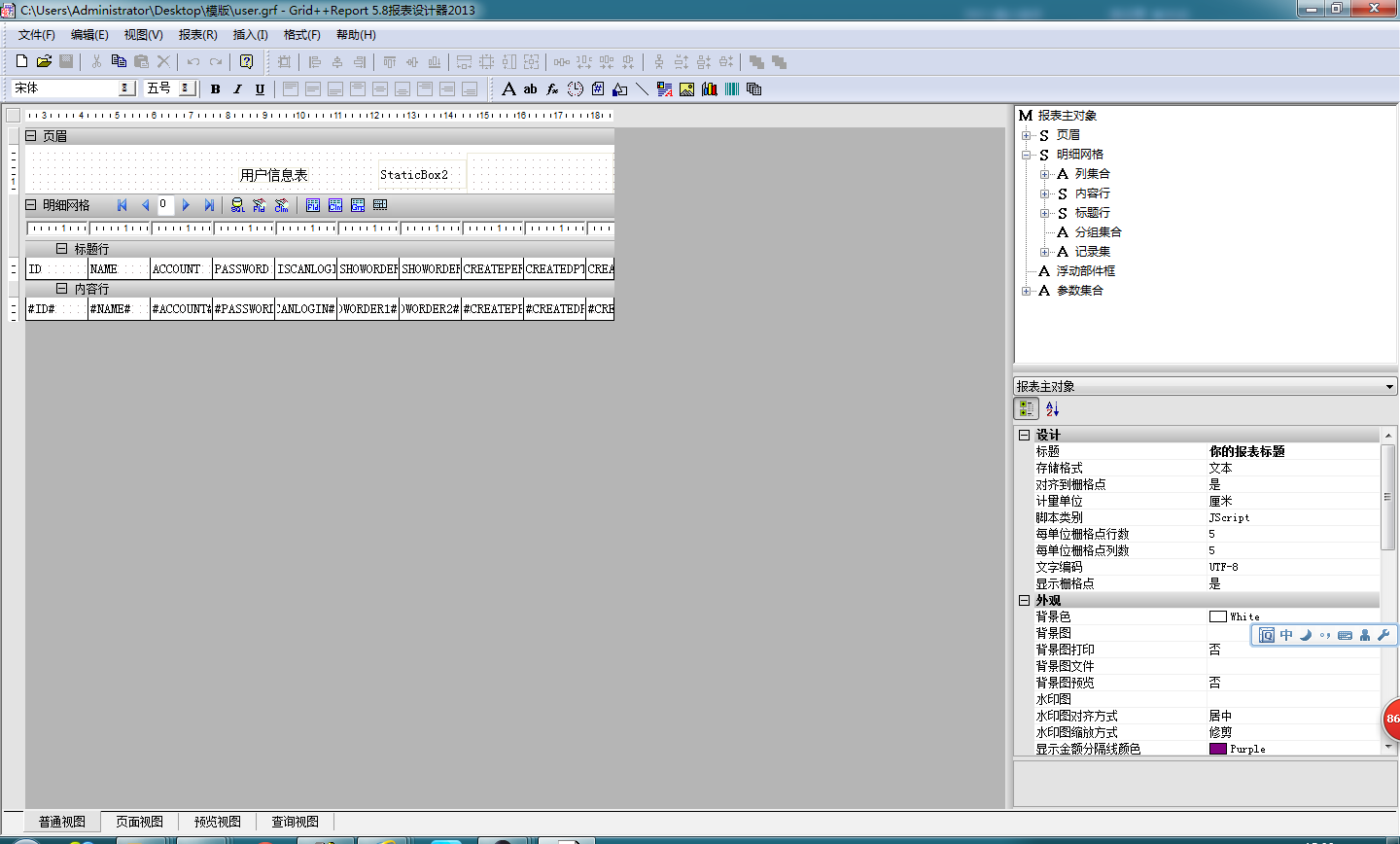hibernate+spring+mvc+Easyui框架模式下使用grid++report的总结
最近刚开始接触hibernate+spring+mvc+Easyui框架,也是刚开通了博客,希望能记录一下自己实践出来的东西,让其他人少走弯路。
转让正题,以个人浅薄的认识hibernate对于开发人员的作用主要是节省了写sql连接数据库的时间,而grid++report内部提供的类来看,却是通过ajax直接连接数据库,还是需要写sql。感觉把grid++report用到这个框架里来的话,给人的感觉就是一匹快马,拉了一辆旧车,虽然速度上影响不了多少,但是审美感觉上很不爽。作为一个完美主义的程序员来说,这是不允许的。然后我就贱贱的尝试着怎么改掉它。关于hibernate+spring+mvc+Easyui框架的东西我就不说了,我只说一下grid++report的使用。
1、打开grid++report客户端,连接数据库并绘制报表。

2.绘制完成后使用记事本打开.grf文件,把里面的数据库连接给清掉。

3.添加mvc的三个文件在html中载入.grf文件这个不细说,grid++的demo里多的是。
4.修改载入的数据源url
ReportViewer.Stop(); ReportViewer.DataURL = "user/load"; // var BeginDate = document.getElementById("txtBeginDate").value; // var EndDate = document.getElementById("txtEndDate").value; // var DataURL = encodeURI("xmlSummary.aspx?BeginDate=" + BeginDate + "&EndDate=" + EndDate); // ReportViewer.DataURL = DataURL; //更新查询参数更新报表付标题,设置对应静态框的“Text”属性 //ReportViewer.Report.ControlByName("SubTitle").AsStaticBox.Text = "日期范围:" + BeginDate + "至" + EndDate; ReportViewer.Start();
5.在control中编写load方法获取数据源,由于框架中使用hibernate获得的数据源格式为IList<T>格式,而grid++中接收的是xml格式。所以需要方法把这给转换一下。
度娘告诉我是这样转
using System; using System.Collections.Generic; using System.Linq; using System.Text; using System.Xml; namespace Common.ToolsHelper { public class XMLHelperToList<T> where T : new() { #region 实体类转成Xml /// <summary> /// 对象实例转成xml /// </summary> /// <param name="item">对象实例</param> /// <returns></returns> public static string EntityToXml(T item) { IList<T> items = new List<T>(); items.Add(item); return EntityToXml(items); } /// <summary> /// 对象实例集转成xml /// </summary> /// <param name="items">对象实例集</param> /// <returns></returns> public static string EntityToXml(IList<T> items) { //创建XmlDocument文档 XmlDocument doc = new XmlDocument(); //创建根元素 XmlElement root = doc.CreateElement(typeof(T).Name + "s"); //添加根元素的子元素集 foreach (T item in items) { EntityToXml(doc, root, item); } //向XmlDocument文档添加根元素 doc.AppendChild(root); return doc.InnerXml; } private static void EntityToXml(XmlDocument doc, XmlElement root, T item) { //创建元素 XmlElement xmlItem = doc.CreateElement(typeof(T).Name); //对象的属性集 System.Reflection.PropertyInfo[] propertyInfo = typeof(T).GetProperties(System.Reflection.BindingFlags.Public | System.Reflection.BindingFlags.Instance); foreach (System.Reflection.PropertyInfo pinfo in propertyInfo) { if (pinfo != null) { //对象属性名称 string name = pinfo.Name; //对象属性值 string value = String.Empty; if (pinfo.GetValue(item, null) != null) value = pinfo.GetValue(item, null).ToString();//获取对象属性值 //设置元素的属性值 xmlItem.SetAttribute(name, value); } } //向根添加子元素 root.AppendChild(xmlItem); } #endregion #region Xml转成实体类 /// <summary> /// Xml转成对象实例 /// </summary> /// <param name="xml">xml</param> /// <returns></returns> public static T XmlToEntity(string xml) { IList<T> items = XmlToEntityList(xml); if (items != null && items.Count > 0) return items[0]; else return default(T); } /// <summary> /// Xml转成对象实例集 /// </summary> /// <param name="xml">xml</param> /// <returns></returns> public static IList<T> XmlToEntityList(string xml) { XmlDocument doc = new XmlDocument(); try { doc.LoadXml(xml); } catch { return null; } if (doc.ChildNodes.Count != 1) return null; if (doc.ChildNodes[0].Name.ToLower() != typeof(T).Name.ToLower() + "s") return null; XmlNode node = doc.ChildNodes[0]; IList<T> items = new List<T>(); foreach (XmlNode child in node.ChildNodes) { if (child.Name.ToLower() == typeof(T).Name.ToLower()) items.Add(XmlNodeToEntity(child)); } return items; } private static T XmlNodeToEntity(XmlNode node) { T item = new T(); if (node.NodeType == XmlNodeType.Element) { XmlElement element = (XmlElement)node; System.Reflection.PropertyInfo[] propertyInfo = typeof(T).GetProperties(System.Reflection.BindingFlags.Public | System.Reflection.BindingFlags.Instance); foreach (XmlAttribute attr in element.Attributes) { string attrName = attr.Name.ToLower(); string attrValue = attr.Value.ToString(); foreach (System.Reflection.PropertyInfo pinfo in propertyInfo) { if (pinfo != null) { string name = pinfo.Name.ToLower(); Type dbType = pinfo.PropertyType; if (name == attrName) { if (String.IsNullOrEmpty(attrValue)) continue; switch (dbType.ToString()) { case "System.Int32": pinfo.SetValue(item, Convert.ToInt32(attrValue), null); break; case "System.Boolean": pinfo.SetValue(item, Convert.ToBoolean(attrValue), null); break; case "System.DateTime": pinfo.SetValue(item, Convert.ToDateTime(attrValue), null); break; case "System.Decimal": pinfo.SetValue(item, Convert.ToDecimal(attrValue), null); break; case "System.Double": pinfo.SetValue(item, Convert.ToDouble(attrValue), null); break; default: pinfo.SetValue(item, attrValue, null); break; } continue; } } } } } return item; } #endregion } }
然后自己获取数据并Response到页面上
方法如下。
using System; using System.Collections.Generic; using System.Linq; using System.Web; using System.Web.Mvc; using System.IO; using CLGL.Web.Controllers; using System.Text; using Wat.Common; using Domain; using System.IO.Compression; using Newtonsoft.Json; using System.Globalization; using Common.ToolsHelper; namespace CLGL.Web.Areas.GrfDemo.Controllers { public class UserController : Controller { // // GET: /GrfDemo/User/ Service.IUserManager userManage { get; set; } //User user = new User(); public ActionResult Index() { return View(); } public ActionResult Load() { IList<User> list = userManage.LoadAll(); string str = XMLHelperToList<User>.EntityToXml(list); Response.Write(str); Response.End(); return View(); } } }
运行后,结果:



